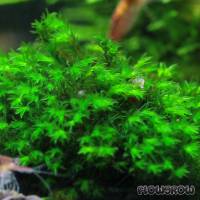



This cushion-forming moss first came to Europe when it was imported from Asia. Armin Piątkowski (Poland) made it known in aquaristics. Prof. Benito C. Tan (Singapore) identified it as a species of the genus Barbula in 2007. As its origins are unknown its exact species could hitherto not be determined yet.
Mosses of the genus Barbula are distributed in all the world. The genus comprehends around 200 species, which occur on soil or rocks. Barbula convoluta e.g. is found in the cracks of the pavement and walls in old cities in Europe. These mosses are not aquatic, however, some species grow in wet locations, too.
The shoots of Barbula sp. grow to a length of over 2.5 cm, ramifying mainly in their lower parts, which gives the plant a cushion-like growth habit. The up to 2 mm long leaves grow densely around the stem. They are obovate to lanceolate and have a distinct midrib that reaches the acute leaf tip. The leaf cells are arranged in longitudinal rows parallel to the midrib, rectangular to hexagonal in shape. Near the leaf base they have a longish form, and in the upper to middle part of the leaf they are only a little longer than wide.
To be continued...
<a href="https://www.flowgrow.de/db/aquaticplants/barbula-sp" target="_blank"><img alt="Barbula sp." title="Barbula sp." src="https://www.flowgrow.de/db/widget/aquaticplants/barbula-sp" /></a>
[url=https://www.flowgrow.de/db/aquaticplants/barbula-sp][img]https://www.flowgrow.de/db/widget/aquaticplants/barbula-sp[/img][/url]
[widget=aquaticplants/barbula-sp]Barbula sp.[/widget]